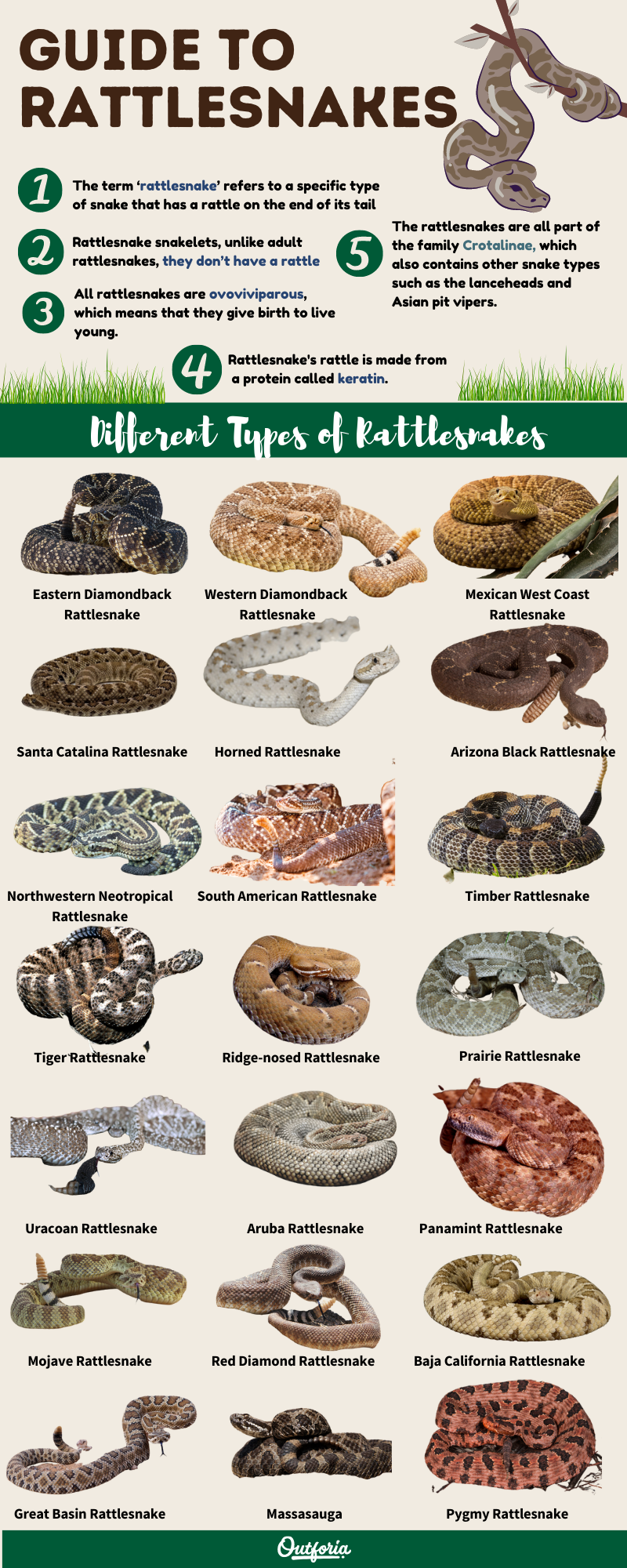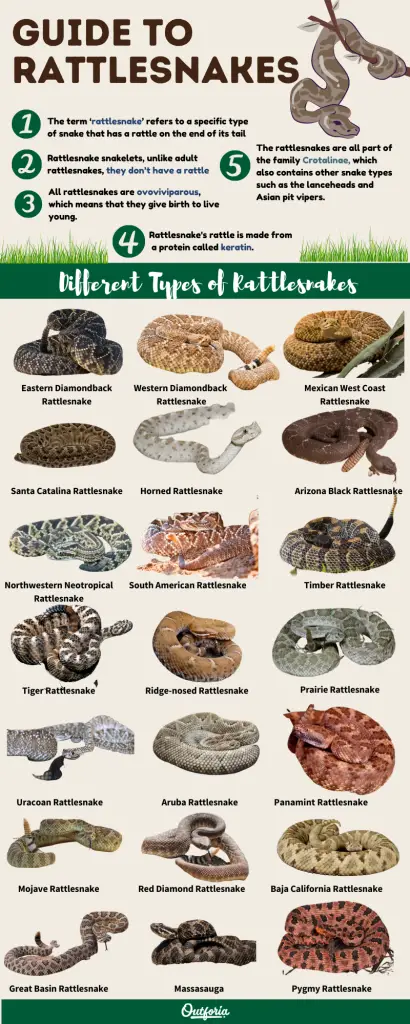Rattlesnakes are fascinating creatures that have been the subject of much curiosity for years. But have you ever wondered how many species of rattlesnakes there are?
The answer is not as straightforward as you might think. While there are some commonly known species, there are also several lesser-known types that make the rattlesnake family quite diverse. In this article, we will explore the different species of rattlesnakes that exist, and what makes each one unique. So, let’s dive in and discover the world of rattlesnakes!
There are 36 recognized species of rattlesnakes. Rattlesnakes are venomous snakes that are found throughout North and South America. They are easily identified by the rattle on the end of their tail, which they use as a warning signal to potential predators. Rattlesnakes vary in size, coloration, and behavior, but all are capable of delivering a potentially deadly bite. If you encounter a rattlesnake in the wild, it’s best to give it plenty of space and respect its territory.

How Many Species of Rattlesnakes Are There?
Rattlesnakes are one of the most recognizable species of venomous snakes in the world. These reptiles belong to the genus Crotalus and are found throughout the Americas, from southern Canada to Argentina. Although they share many common characteristics, there are actually a wide variety of different species of rattlesnakes. In this article, we will explore the different types of rattlesnakes and how many species there are.
1. Eastern Diamondback Rattlesnake
The Eastern Diamondback Rattlesnake is the largest venomous snake in North America, with some specimens growing up to eight feet in length. This species is found in the southeastern United States, from North Carolina to Florida. The Eastern Diamondback Rattlesnake has a distinctive diamond pattern on its back and a thick, muscular body.
There are several benefits to having rattlesnakes in the ecosystem. For example, they help control rodent populations, which can carry diseases harmful to humans. However, it’s important to remember that these snakes are venomous and should be approached with caution.
2. Western Diamondback Rattlesnake
The Western Diamondback Rattlesnake is found throughout the southwestern United States and northern Mexico. This species is similar in appearance to the Eastern Diamondback Rattlesnake, but is typically smaller, with an average length of four to five feet.
One of the biggest differences between these two species is their venom. The Western Diamondback Rattlesnake has a more potent venom than the Eastern Diamondback Rattlesnake, which can cause more severe symptoms in humans.
3. Sidewinder Rattlesnake
The Sidewinder Rattlesnake is named for its unique method of movement, which involves moving sideways across the sand. This species is found in the deserts of the southwestern United States and northern Mexico.
The Sidewinder Rattlesnake is a relatively small species, with an average length of two to three feet. Despite their small size, they are still venomous and should be approached with caution.
4. Timber Rattlesnake
The Timber Rattlesnake is found in the eastern United States, from Minnesota to Florida. This species is typically brown or gray in color, with a distinctive pattern of dark bands on its back.
In addition to their venomous bite, Timber Rattlesnakes can also use their tails to produce a rattling sound as a warning to potential predators.
5. Massasauga Rattlesnake
The Massasauga Rattlesnake is found in the Great Lakes region of the United States and Canada. This species is relatively small, with an average length of two to three feet.
One of the biggest threats to the Massasauga Rattlesnake is habitat loss, as their wetland habitats are often drained or destroyed for development.
6. Mojave Rattlesnake
The Mojave Rattlesnake is found in the deserts of the southwestern United States and northern Mexico. This species is unique in that it has two different types of venom, one of which is neurotoxic and the other of which is hemotoxic.
The Mojave Rattlesnake is considered to be one of the most dangerous species of rattlesnake because of its potent venom.
7. Prairie Rattlesnake
The Prairie Rattlesnake is found in the central and western United States, from Montana to Texas. This species is typically yellow or greenish-brown in color, with a distinctive pattern of dark blotches on its back.
Despite their venomous bite, Prairie Rattlesnakes are relatively docile and will often try to avoid confrontation with humans.
8. Black-tailed Rattlesnake
The Black-tailed Rattlesnake is found in the western United States and northern Mexico. This species is typically brown or gray in color, with a distinctive black tail.
Black-tailed Rattlesnakes are known for their potent venom, which can cause severe symptoms in humans if left untreated.
9. Eastern Massasauga Rattlesnake
The Eastern Massasauga Rattlesnake is found in the eastern United States and Canada. This species is relatively small, with an average length of two to three feet.
The Eastern Massasauga Rattlesnake is listed as a threatened species in many areas, due to habitat loss and fragmentation.
10. Speckled Rattlesnake
The Speckled Rattlesnake is found in the southwestern United States and northern Mexico. This species is typically gray or brown in color, with a distinctive pattern of small, dark spots on its back.
Despite their venomous bite, Speckled Rattlesnakes are relatively docile and will often try to avoid confrontation with humans.
In conclusion, there are approximately 36 different species of rattlesnakes found throughout the Americas. Each species has its own unique characteristics and venom, and should be approached with caution. However, it’s important to remember that these snakes play an important role in the ecosystem, and help control rodent populations.
Frequently Asked Questions
What is a rattlesnake?
A rattlesnake is a venomous snake that belongs to the genus Crotalus. These snakes are found throughout the Americas, from southern Canada to Argentina. Rattlesnakes are known for the rattle on the end of their tails, which they use to warn potential predators.
Rattlesnakes are carnivorous and feed on a variety of prey, including rodents, birds, and other snakes. They are important predators in their ecosystems and play a vital role in controlling rodent populations.
Where are rattlesnakes found?
Rattlesnakes are found throughout the Americas, from southern Canada to Argentina. They are most commonly found in the southwestern United States and Mexico, but can also be found in other parts of North and South America. Rattlesnakes prefer dry, rocky habitats, but can also be found in forests, deserts, and prairies.
Rattlesnakes are important members of their ecosystems and play a vital role in controlling rodent populations. However, they can also pose a threat to humans and pets, and it is important to take precautions to avoid rattlesnake bites.
What are the different types of rattlesnakes?
There are over 30 species of rattlesnakes found throughout the Americas. Some of the most common species include the western diamondback rattlesnake, the eastern diamondback rattlesnake, the timber rattlesnake, and the prairie rattlesnake.
Each species of rattlesnake has its own unique characteristics, such as size, coloration, and behavior. Some species are more venomous than others, and it is important to be able to identify different types of rattlesnakes in order to stay safe in their habitat.
What do rattlesnakes eat?
Rattlesnakes are carnivorous and feed on a variety of prey, including rodents, birds, and other snakes. They are important predators in their ecosystems and play a vital role in controlling rodent populations.
Rattlesnakes use their venom to immobilize their prey, which they then swallow whole. They have flexible jaws that allow them to consume prey that is much larger than their own heads.
How can I avoid a rattlesnake bite?
The best way to avoid a rattlesnake bite is to be aware of your surroundings and take precautions when you are in rattlesnake habitat. Wear long pants and sturdy boots when hiking or working in areas where rattlesnakes may be present.
If you encounter a rattlesnake, give it plenty of space and do not attempt to handle it. Rattlesnakes will usually try to avoid humans if possible, but they may feel threatened if they are cornered or provoked.
If you are bitten by a rattlesnake, seek medical attention immediately. Rattlesnake bites can be very serious and can cause permanent damage or even death if not treated promptly.
All Rattlesnake species / types of Rattlesnake / rattle snake
In conclusion, the exact number of rattlesnake species is still a topic of debate among experts. While some sources claim there are 36 species, others suggest there may be up to 47 or more. Regardless of the exact number, it is clear that rattlesnakes play an important ecological role in their respective habitats.
Despite their reputation as dangerous predators, rattlesnakes are fascinating creatures with a unique set of adaptations that have allowed them to survive for millions of years. From their heat-sensing pits to their venomous fangs, these snakes are truly remarkable.
As we continue to learn more about rattlesnakes and their importance to the ecosystem, it is important to remember to treat these animals with respect and caution. By doing so, we can help ensure that these fascinating creatures continue to thrive for generations to come.


